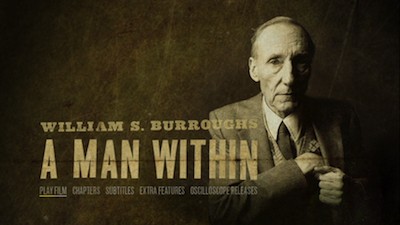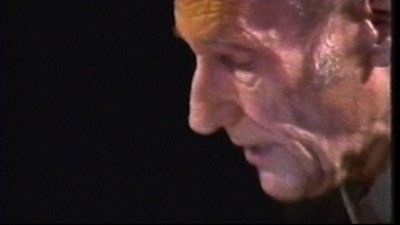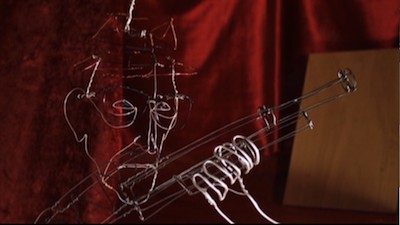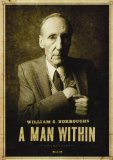| Reviews & Columns |
|
Reviews DVD TV on DVD Blu-ray 4K UHD International DVDs In Theaters Reviews by Studio Video Games Features Collector Series DVDs Easter Egg Database Interviews DVD Talk Radio Feature Articles Columns Anime Talk DVD Savant Horror DVDs The M.O.D. Squad Art House HD Talk Silent DVD
|
DVD Talk Forum |
|
|
| Resources |
|
DVD Price Search Customer Service #'s RCE Info Links |
|
Columns
|
|
|
William S. Burroughs: A Man Within
THE MOVIE:

The Beats have always been a school of writers that I've been more interested in as personalities than I have been in reading their work. I particularly have no affinity for the writing of William S. Burroughs, whose offbeat cadence might make him interesting to listen to, but when applied to the written page, turns into so much gobbledygook. It inspires almost a weird dyslexia for me, like I am staring at a random jumble of letters that refuse to get into the proper order.
I share this with you by way of underlining what an achievement it is, then, that Yony Leyser has made me understand the man and his work as I never have before. His film William S. Burroughs: A Man Within valiantly tackles the mercurial personality of the notorious writer, and it is surprisingly effective at unraveling the knotted persona the author created for himself.
Born in 1914, Burroughs first came to prominence in the 1950s, alongside other writers of the "Beat Generation," like Allen Ginsburg and Jack Kerouac. As A Man Within points out, however, Burroughs was never quite in line with the group, he was an outsider even in a band of outsiders. He fearlessly wrote about his drug addiction and his homosexuality at a time before either had been romanticized or even remotely accepted, and throughout his life, he kicked against any defining structure. To be William Burroughs was to remain undefined.
Armed with that knowledge, Leyser steps into the arena undaunted, ready to wrestle with this cagey character. He's outfitted himself with a cadre of weapons: archival footage of Burroughs; new interviews with friends, contemporaries, and admirers; and of course the man's writing itself. Leyser and his editor, Ilko Davidov, sift through all of this and shake out the gold, and for the most part, do a great job of it. A Man Within is best when it stays focused on that particular idea, that there is a person hidden behind the personality. Segments on Burroughs' early childhood, his romantic life, and his tragic shooting of his wife during a game of "William Tell" cover ground that maybe has been covered before, but Leyser makes fascinating connections between these events and the coded themes of Burroughs' books. In terms of his later life, there are also excellent segments about the author's love of guns and cats, his failure as a father, and stories from lovers and assistants who knew him in his final years.
Where A Man Within isn't nearly as good is when we stray off the main subject and get deeper into how he influenced pop culture and, particularly, the world of music. Even as an old punk fan, I was a little bored by the sycophantic reverence that subculture bequeathed on Burroughs. Granted, the commentators for that specific era also provide a lot of the great insight elsewhere in the picture. Some of the talking heads Leyser turned up include Patti Smith, Iggy Pop, John Waters, Jello Biafra, and Thurston Moore and Lee Ranaldo from Sonic Youth. Even if this stuff doesn't do as much to expose the man behind the myth, it does validate the myth. If nothing else, Leyser does make the audience believe that Burroughs was every bit the rebel others believe him to be.

THE DVD
Video:
William S. Burroughs: A Man Within has a decent 1.78:1 anamorphic transfer. It's good, but it's not up to what I normally expect from Oscilloscope. There seemed to be more jagged edges and a general softness to the film, and not just in the older archive footage, either. Granted, it's not an entirely exciting movie in terms of cinematography, but the digital authoring lacks snap.
Sound:
The stereo soundtrack has good balance, keeping the essential information clear in the mix even as it weaves disparate elements like Burroughs reading his own work and the musical score into the new interviews. There is never a question of what you should be hearing or a need to strain to hear it.
There are optional English subtitles, as well.
Extras:
As usual, Oscilloscope has put together a lovely package, with a three-paned foldable book and an outer slipcover, all printed on sturdy recycled material. I enjoy the grain of their paper, I am not going to lie. Rub your hands over it, you'll see what I mean. The packaging is handsomely designed, and the inside has liner notes by musicians David Byrne and Richard Hell.
In the extras department, we get plenty more about Burroughs' home life and his later attempts at painting. For the latter, there are three deleted scenes that further explore his visual art, including Burroughs sharing his theories on the subject, and also another demonstration of his shotgun art--shooting paint cans placed in front of plywood and capturing the splatter--here accompanied by music from Husker Du. There are just over 15 minutes of home movies, which include the author hanging with his friends, such as Patti Smith and Steve Buscemi (who does not appear in the main feature), and an added movie of Sonic Youth visiting Burroughs, which is put together and narrated by the band and was excerpted in A Man Within. The music connection gets added coverage via a video of Patti Smith reading "Psalm 23 Revisited" (Patti also performs impromptu in the home movies). Finally, there is a "music video" called "Rub Out the World" that features Burroughs reading "The Last Words of Hassan Sabbah."
The Naked Lunch 50th anniversary featurette (about 15 minutes) celebrates the book and David Cronenberg's movie adaptation, and it has tributes by poets and other fans and friends plus an excerpt of Peter Weller reading. (Weller also narrates A Man Within and appears on camera.) It was shot in Chicago in 2009.
For those looking to hear more about the documentary, Yony Leyser answers questions at the BFI (just over 10 minutes), giving a little more insight into the project.
FINAL THOUGHTS:
For fans and non-fans alike, William S. Burroughs: A Man Within offers an insightful, inviting look at a unique personality and his art. The movie is best when it is poking around at what makes the author tick, but the overall image of Burroughs and the impact he had on the artistic community of the late 20th Century is enough of its own story to keep the documentary moving along. The DVD is packed out with excellent special features, making A Man Within easily Recommended.

Jamie S. Rich is a novelist and comic book writer. He is best known for his collaborations with Joelle Jones, including the hardboiled crime comic book You Have Killed Me, the challenging romance 12 Reasons Why I Love Her, and the 2007 prose novel Have You Seen the Horizon Lately?, for which Jones did the cover. All three were published by Oni Press. His most recent projects include the futuristic romance A Boy and a Girl with Natalie Nourigat; Archer Coe and the Thousand Natural Shocks, a loopy crime tale drawn by Dan Christensen; and the horror miniseries Madame Frankenstein, a collaboration with Megan Levens. Follow Rich's blog at Confessions123.com.
|
| Popular Reviews |
| Sponsored Links |
|
|
| Sponsored Links |
|
|
| Release List | Reviews | Shop | Newsletter | Forum | DVD Giveaways | Blu-Ray | Advertise |
|
Copyright 2024 DVDTalk.com All Rights Reserved. Legal Info, Privacy Policy, Terms of Use,
Manage Preferences,
Your Privacy Choices | |||||||













